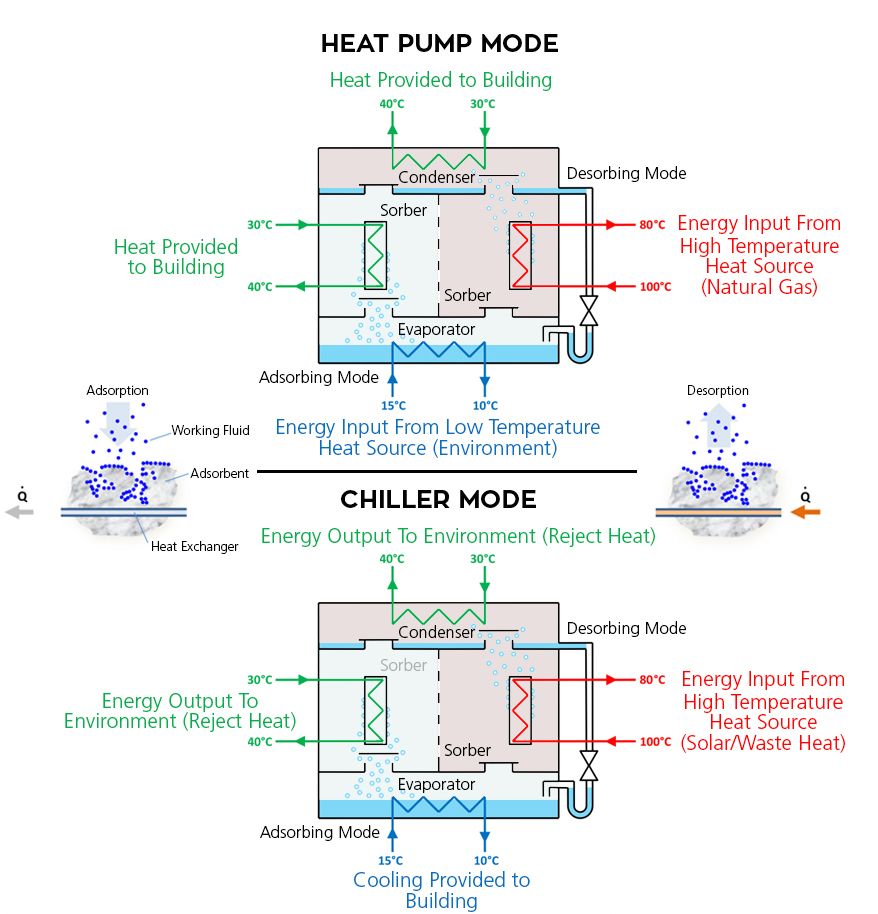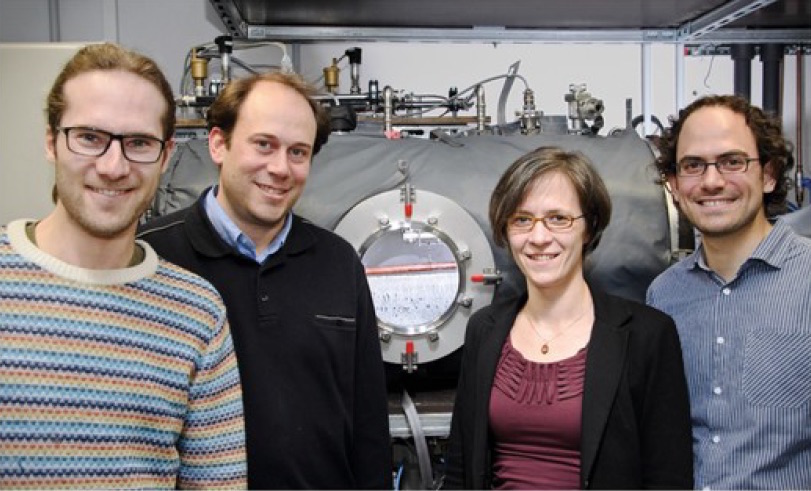
Keeping buildings cool in the summer and warm in the winter is a major drain on energy resources. In search of a more cost-effective and energy-efficient way to heat and cool buildings, researchers at Fraunhofer ISE continuously work to develop adsorption-based systems that run on solar energy, natural gas, and industrial waste. Using COMSOL Multiphysics® simulation software, the team investigates the adsorption process, heat exchanger design, and numerous other systems that affect their innovative developments in adsorption technology.
Adsorption-Based Heating and Cooling for Buildings
Adsorption-based heating and cooling relies on heat instead of electricity. Heat is generated from solar energy collectors, the waste produced by industrial facilities, or even combined heat and power units. The Fraunhofer Institute for Solar Energy Systems (Fraunhofer ISE) is a leader in this area of solar energy research. Their work involves developing and improving adsorption-based systems to control buildings’ climates.
The system includes a working fluid that is kept in a continuous adsorption and desorption cycle. The fluid is repeatedly altered from liquid to gas, from gas to an adsorbed state, and vice versa. Specially designed heat exchangers act as thermal compressors to heat and cool an adsorbent material at different pressures and temperatures over a periodic cycle. When it comes to keeping a building warm or cool, the system either draws energy from the environment to heat the building or releases energy from the building into the environment to cool it.

The continuous heating and cooling process in an adsorption-based system. Copyright © Fraunhofer ISE.
The benefits to this type of process include increased energy efficiency and reduced carbon emissions, providing a more environmentally friendly climate control process. Adsorption-based systems can also store energy for a long period of time, as compared to electricity-based systems.
Within Fraunhofer ISE, one research team is working to develop higher-efficiency heat exchangers for use in these adsorption-based systems. To do so, they focus on how water vapor and heat behave as they flow through porous structures. This is in order to optimize the size and efficiency of the system. They also studynonisothermal fluid flowand heat conduction in the system’s solids to enhance the architecture of the heat exchangers.

The heat exchanger research team at Fraunhofer ISE. From left to right: Hannes Fugmann, Gerrit Füldner, Lena Schnabel, and Eric Laurenz. Copyright © Fraunhofer ISE.
One challenge to the development of these types of systems is that they are difficult and complicated to analyze. This is due to discontinuous operating cycles and constantly changing peak energy fluxes. Also, the dynamic behavior of adsorption-based systems is controlled by coupled heat and mass transfer phenomena, a complex subject to analyze.
Let’s see how the research team at Fraunhofer ISE uses COMSOL Multiphysics simulation software to optimize their innovative adsorption-based systems, improving how we heat and cool buildings.
Using Simulation to Understand and Optimize the Solar Heating and Cooling System
The team used a combination of simulations and small-scale experiments in their research. This enabled them to find data that they used to create large-scale models to accurately predict the real-world behavior of the adsorption-based system. Performing the smaller simulations first and using that data allowed them to build a bigger model that wasn’t as computationally expensive. This procedure was performed for two main aspects of the system: the adsorption process and heat exchanger design.
First, the team wanted to validate the adsorption process itself, in order to enhance both the uptake speed and capacity of the thin sorbent layers of the system. To do this, they modeled the interplay dynamics between the heat and mass transfer within the layers. The team was able to identify the transport coefficients in COMSOL Multiphysics that could not be measured directly, and use that data in a larger, more complex model.
The team then turned to the design of heat exchangers in the adsorption system and in attached installations for heat and cold distribution in buildings. Unlike regular fin and tube heat exchangers, the design used in their concepts is made up of wire structures, which increase the heat transfer coefficient and surface area while using less material. The researchers were able to use COMSOL Multiphysics to perform multiple parametric sweeps for the heat exchanger’s specific pressure drops, heat transfer coefficients, material usage, and overall analysis of the geometry itself.

Simulation results show velocity streamlines and temperature distribution in the air, tubes, and wires (left) and velocity magnitude in the air (right). Copyright © Fraunhofer ISE.
By analyzing both the adsorption process and the design of the heat exchangers used in the system, the team at Fraunhofer ISE was able to enhance their adsorption-based climate control system for heating and cooling buildings. Looking ahead, they hope to continue improving the system for both customers and partners, and someday see widespread use of this technology to conserve Earth’s energy.
Further Reading
- Read more about how Fraunhofer ISE uses simulation to enhance their adsorption-based heating and cooling system on page 36 ofCOMSOL News2015.



Comments (1)
mona aghaee
January 29, 2018Hi,
I have problem modeling radiation heat transfer in a slab. A constant radiation hits an slab and part of that is transferred through the slab, part is absorbed within the slab and part is reflected. How should I model this? I already know the absorptance, reflectance and transmittance coefficients of the slab. Please advise.
Thanks
Mona